History of Microscopes - Who Invented the Microscope?
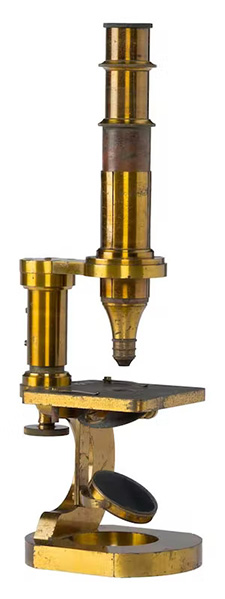
100 AD: Looking Through Glass
During the 1st century AD (year 100), glass had been invented and the Romans were looking through the glass and testing it. They experimented with glass in different shapes and ultimately found that different thickness of glass could produce magnification by holding one of these “lenses” over an object.
Someone also discovered that you can focus the rays of the sun with one of these special “glasses” and start a fire. These early lenses were called magnifiers or burning glasses. These lenses were not used much until the end of the 13th century when eyeglass makers were producing lenses to be worn as glasses.
The early simple “microscopes” which were really only magnifying glasses had one power, usually about 10x .People found fleas and insects interesting to look at and these early microscopes were frequently used to view insects.
1590 - 1660: Rearranging Eye Glasses
In the late 1500s two Dutch eyeglass makers (Zaccharias and Hans Janssen) were working with their glasses and discovered that if they put several glass lenses inside a tube the object near the end of the tube would appear much larger. This is the same feature found inside a compound microscope!
Galileo heard of their experiments and started experimenting on his own. He described the principles of lenses and light rays and improved both the microscope and telescope. He added a focusing device to his microscope and then he went on to explore the heavens with his telescopes.
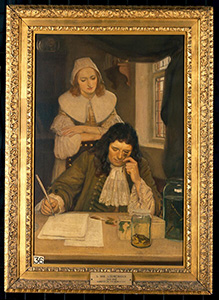 In the 1660s in Holland, Antonie van Leeuwenhoek also started playing with lenses. He realized that he could grind and polish lenses so they would have curves on the edges to produce greater magnification. His rounded lenses allowed his microscope to magnify up to 270x!
In the 1660s in Holland, Antonie van Leeuwenhoek also started playing with lenses. He realized that he could grind and polish lenses so they would have curves on the edges to produce greater magnification. His rounded lenses allowed his microscope to magnify up to 270x!
Because Leeuwenhoek’s microscope was able to magnify greater than what the naked eye could see, he opened up a world that included being able to view tiny animals swimming in water, blood cells, yeast, and even bacteria. Leeuwenhoek is often called the father of microscopy due to his discoveries and he is often given credit for inventing the microscope.
The image at left is Leeuwenhoek with his microscope. Source: Painting by Ernest Board, Wellcome Collection (CC BY).
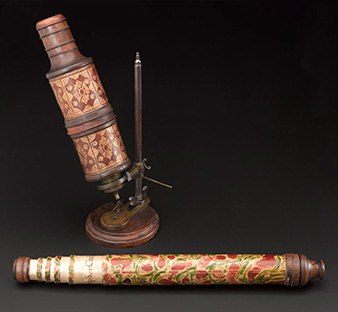 1665: Microscopes Discover Cells
1665: Microscopes Discover Cells
In 1665 Micrographia was published by Robert Hooke. Microgaphia was filled with drawings of objects he had observed with his compound microscope. He was the first person to use the word “cell” when describing living organisms.
The image at right is the compound microscope designed by Robert Hooke. Source: Science Museum Group.
For the next 200 years the microscope did not change much. Mirrors were eventually added to compound microscopes to provide more light. Many people refused to use microscopes because they did not trust the images they saw.
1830s: Fixing Spherical and Chromatic Aberrations
There were 2 main problems hindering lens manufacturing:
- Image Blurring (Spherical Aberration)
- Color Separation (Chromatic Aberration)
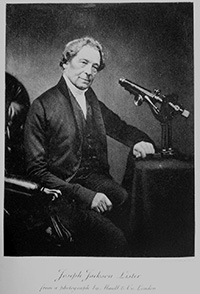 Around 1830 Joseph Jackson Lister, along with William Tulley, made one of the first microscopes that corrected for both of these faults. With these 2 major issues resolved, the use of microscopes in science and medicine grew rapidly.
Around 1830 Joseph Jackson Lister, along with William Tulley, made one of the first microscopes that corrected for both of these faults. With these 2 major issues resolved, the use of microscopes in science and medicine grew rapidly.
1830s: Bringing the Microscope Into the Laboratory
In the 1830s, thanks to the improvements in the microscope, cells became a larger focus in medical research.
In 1838 two Germany scientists, Mathias Schleiden and Theodor Schwann proposed that cells were the building blocks for plant and animal life. They published "Mikroskopie", of which an excerpt is shown below.
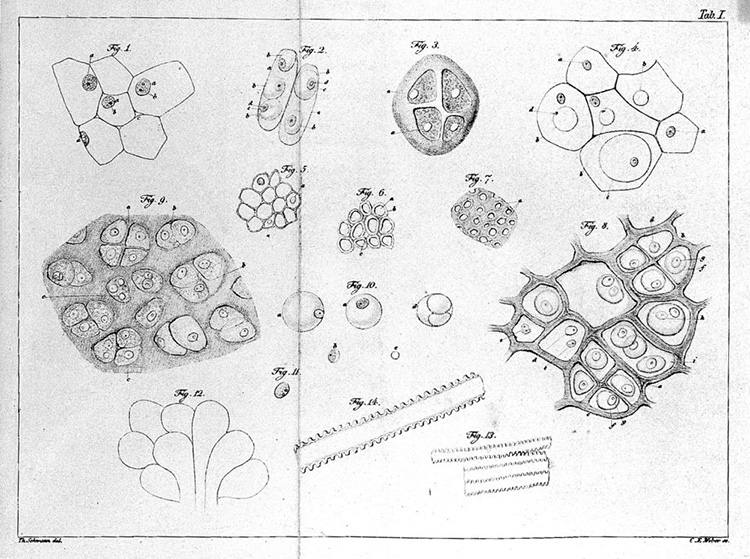
Schwann's "Mikroskopie" 1839, Wellcome Collection (CC BY).
1850s: Carl Zeiss and Ernst Abbe Improve Microscopes

 Carl Zeiss opened a workshop for optical instruments in Jena, Germany in 1846. He recruited physicist Ernst Abbe to help him improve microscopes.
Carl Zeiss opened a workshop for optical instruments in Jena, Germany in 1846. He recruited physicist Ernst Abbe to help him improve microscopes.
The image at right is the Carl Zeiss' first compound microscope.
1877: First Oil Immersion Objective Lens Developed
In 1877 the first homogeneous oil immersion objective lens was developed after John Ware Stephenson thought of the idea
1889: Carl Zeiss Foundation Established (Remains Today!)
After Carl Zeiss passed away, Ernst Abbe created the Carl Zeiss Foundation in 1889, which would become the company’s sole owner. The Carl Zeiss Foundations’ profits went toward science, social and cultural projects, and the workforce. This foundation still exists today.
Today, there are no microscope manufacturers in the US and most of the microscopes come from China, with higher quality products being produced in Germany and Japan. Toy plastic microscopes provide horrible magnification and should be avoided. Metal frames and glass optics are always superior products that will provide better clarity as well as a longer life.
Because of foreign production, quality microscopes have become affordable for all. Zaccharias Janssen, the inventor of the microscope would marvel at the quality of even the most basic microscopes found in schools today.
